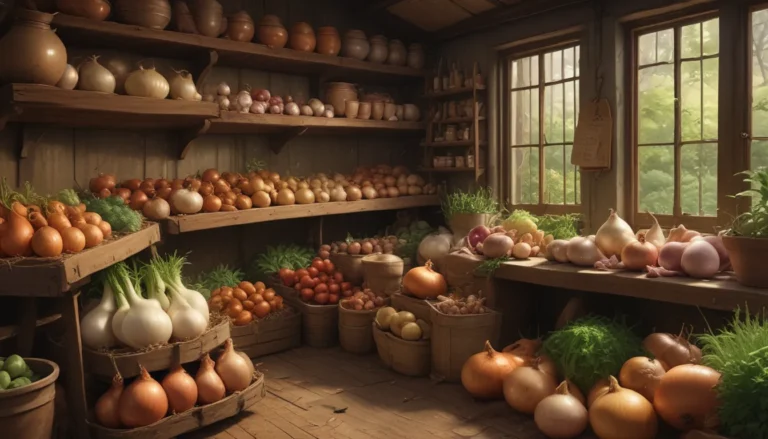Understanding the Gender of Asparagus Plants

When it comes to the world of edible perennials, asparagus (Asparagus officinalis) reigns supreme. This versatile vegetable not only produces delicious spears that mark the beginning of the growing season but also adds a delightful touch to seasonal meals.
Unlike some garden vegetables that are self-pollinating, asparagus plants are dioecious – meaning they have separate male and female plants. The gender of these plants plays a significant role in their reproductive process and ultimately impacts your yearly harvest.
So, let’s dive into the fascinating world of asparagus plant gender differences and learn how to identify the males and females in your garden.
Unveiling the Gender Similarities
Before we explore the distinct characteristics of male and female asparagus plants, it’s essential to understand the similarities that exist between the two genders:
- Both male and female plants produce tender spears that emerge from underground roots known as “crowns.”
- As the spears grow, they turn into tall, frond-like stems called “ferns” that can reach up to 7 feet in height.
- Both genders produce small greenish-white or yellow flowers on the fronds.
Distinguishing Male from Female Asparagus Plants
While the initial stages of asparagus plant development may not reveal their gender differences easily, a closer look at their flowering stage exposes the distinctions more clearly.
Flowers
The flowers of male and female asparagus plants have subtle but noticeable variances. To discern between the two genders, pay attention to the tiny greenish-white or yellow flowers that adorn the plants. Here’s how you can differentiate:
- Male Plants: Male flowers feature visible yellow or orange stamens when viewed inside the petals.
- Female Plants: Female flowers exhibit a green ovary and white pistil beneath the petals.
Additionally, male flowers have a more bell-shaped appearance, while female flowers are typically more spherical in shape.
Berries
One of the significant gender differences in asparagus plants is the production of berries. Female flowers, when pollinated, develop into berries – a trait not commonly found in male plants.
Female asparagus plants may not bear berries until after the first year of planting. Initially green, these berries gradually ripen to a vibrant red color in late summer or fall.
While male plants generally do not produce berries, male hermaphrodites can self-pollinate and occasionally bear fruit. However, such instances are rare compared to female plants.
Volunteers
When female asparagus plants produce berries, there is a possibility of seeds scattering and giving rise to volunteer seedlings. While these uninvited guests can sometimes be viewed as free seedlings, they may compete for nutrients with established crops and overcrowd the garden bed.
Considering that asparagus plants typically live for 15 to 20 years, having a crop of established plants may negate the need for additional seedlings from volunteers. Male plants, which do not produce berries, eliminate the concern of volunteer seedlings.
Yield
The energy invested in berry production sets male and female asparagus plants apart in terms of yield. Male plants, being freed from the burden of bearing fruit, can channel their energy into spear production more efficiently.
For commercial growers, male asparagus plants are considered more profitable due to their higher yields compared to female plants. All-male hybrids, specifically bred to eliminate most females, further enhance productivity and yield significant harvests.
In addition to being more productive, all-male hybrids produce larger spears that are preferred for their tenderness and sweetness. This characteristic, according to experts, enhances the culinary quality of the asparagus crop.
Spear Size
Apart from yielding more spears, all-male hybrids boast larger-sized spears that are coveted for their culinary appeal. The superior tenderness and sweetness of larger diameter spears make them a sought-after choice for both home gardeners and commercial growers.
Male plants also exhibit an advantage in spear production timing, often producing spears earlier in the season than their female counterparts.
Cultivating an All-Male Asparagus Bed
As you strive to maximize your asparagus harvest, opting for all-male asparagus plants can be a strategic choice. Whether you choose store-bought all-male crowns or prefer to cultivate plants from seed, focusing on male varieties can lead to abundant harvests, minimal berry production, and a reduced risk of volunteer seedlings.
However, if you wish to save seeds and perpetuate your asparagus crop, maintaining a balance of male and female plants becomes necessary for successful reproduction.
After gaining insights into the nuances of male and female asparagus plants, it’s time to make an informed decision for your garden. Will you maintain a mix of genders, or will you opt for an all-male bed to enhance your harvest? Share your thoughts with us in the comments below.
To delve deeper into the world of asparagus cultivation, explore our detailed guides on topics such as:
- How to Plant and Care for Asparagus Plants
- Understanding Asparagus Ferning Out
- Pruning Asparagus Foliage in Autumn
- Decoding Purple Spot of Asparagus
As you embark on your asparagus growing journey, remember that the gender of your plants can significantly influence the productivity and longevity of your crop. By embracing this knowledge, you can cultivate a thriving asparagus garden that yields bountiful harvests season after season.
Liked this article? Want to read more insightful gardening tips and tricks? Make sure to stay tuned for our upcoming publications and resources to enhance your gardening expertise.
© Gardening Enthusiasts, LLC. ALL RIGHTS RESERVED. Refer to our Terms of Service for detailed information. Originally published on May 5th, 2023. Last updated on June 12th, 2023. Image credit: Pixabay. Content enhancements by [Your Name].





